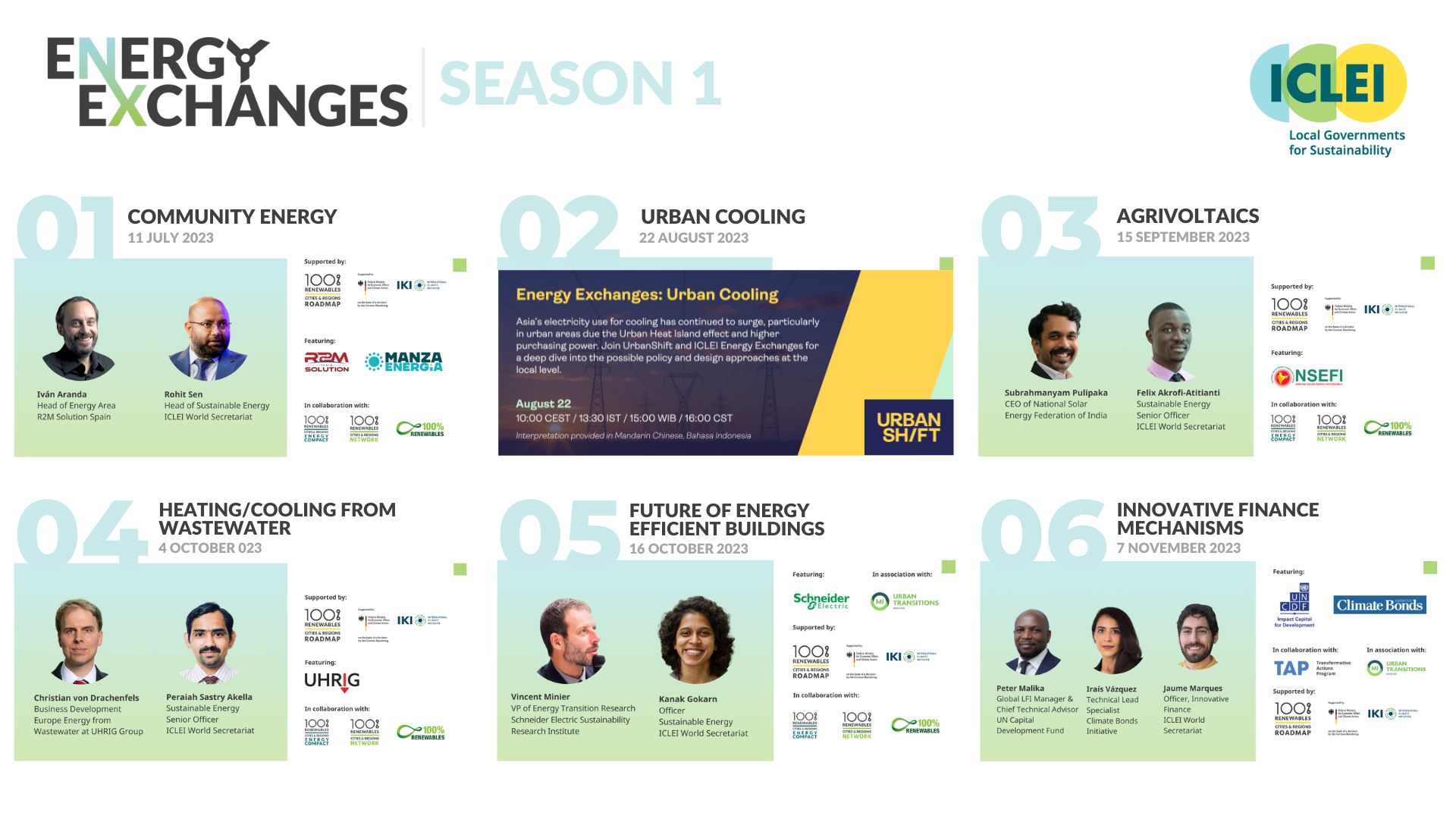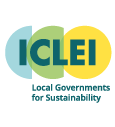Energizing the transition: ICLEI’s Energy Exchanges
The energy transition is a complex and multifaceted process. Cities and regions are at the frontlines given their connection with their communities and their mandates regarding urban planning, buildings, and transport. However, it can be a challenge balancing competing priorities regarding socio-economic welfare, transitioning and ensuring access to decarbonized technologies, and maintaining harmony with nature. Cities and regions the world over have developed ambitious climate, energy, and nature action plans, however the most challenging part remains ahead of them—implementation. Learning from the experiences of their peers and experts in the domain can be a first step to finding actionable solutions that are are responsive to each specific context.
ICLEI’s Energy Exchanges aim to facilitiate this process, providing access to technical asisstance and knowledge for cities and regions to navigate the complexities of the sustainable energy transition at the local level and bridge the gap from planning to action. How can incentives for various actors, including financial institutions, governments, the private sector and communities, be aligned? How can innovation in technology, financing mechanisms, and policy be encouraged and what role can it play? What cutting-edge technologies can help close the gap? What are the key methodologies and applications that should be considered within implementing sustainable energy solutions? These are some of the questions that guide each Exchange.
Season 1
The first season of Energy Exchanges saw six Exchanges held between July and November 2023, covering a range of topics including community energy, energy efficiency and digitalization, wastewater for heating/cooling, agri-voltaics, and innovative financing mechanisms. To allow for in-depth discussions regarding how certain solutions were implemented, each speaker partook in an exchange with experts from ICLEI, followed by an interaction with the audience.

Snapshot of Energy Exchanges Season 1
Community energy and the importance of co-creation
Iván Arranda spoke about community energy approaches in Manzanares El Real in Spain, specifically about the project ManzaEnergía. A key insight that emerged from this project was the importance of social inclusion and the accessibility of information. In addition to continuous and meaningful community engagement from the project’s onset, the project also greatly benefited from the presence of a citizen outreach office in the community. This office provided consultations and information to citizens regarding, including on energy bills and cost savings, etc., assuaging their concerns and making them aware of the benefits of renewable energy generation.
Urban cooling and integrated policy and design approaches
Held in collaboration with the UrbanShift project, this Exchange centered around the critical problem of cooling, focusing on urban areas in Southeast and East Asia. Energy-efficient urban planning, including nature-based solutions and low-cost environmental design techniques, are some solutions to this pressing issue. Yet they must also be supported by enabling policy frameworks at the national level, related to energy efficiency standards more broadly, as well as adequate resources for implementation. Keeping in mind the differential impacts on vulnerable communities, the accessibility of urban cooling options was also considered crucial, and this is where cities and regions can play an important role in designing solutions that are responsive to their communities’ needs through sustained engagement.
Agri-voltaics, land use, and resilience
Subrahmanyam Pulipaka spoke about the technical, financial, and policy and regulatory dimensions that are critical for successful agri-voltaics projects. He emphasized the need for a comprehensive approach that balances agriculture and energy policy to ensure the viability of integrating renewables and agriculture. Using the examples of a 2 MW agri-voltaic system in Delhi, India, and a 1.4 MW agri-voltaic project in Maharashtra, India, he highlighted the various benefits of co-location of crops and solar panels, including diversified farmer incomes from improved crop yields and varieties, the protection of crops from unseasonal weather (which is likely to worsen as climate change intensifies), and the optimal use of resources, including water.
Capitalizing on existing infrastructure—energy from wastewater for heating/cooling
Christian von Drachenfels spoke about the potential of recovering energy from wastewater for heating/cooling. Given that space heating especially is still heavily reliant on fossil fuels, wastewater can provide a renewable alternative. Wastewater energy is an abundant and readily available resource due to the extensive water infrastructure already present in cities, and at a scale that can also enable district energy approaches. Through heat pumps, the wastewater stream can act as a heat sink and can even meet cooling needs. Solar energy can be used to power heat pumps if needed. In addition, the scalability of such projects is flexible—allowing smaller networks to connect with each other and amplifying their collective impact. However, community engagement is also important for acceptability. Christian also highlighted that this is an emerging area, as water and energy companies do not have a long history of working together, and policymakers must also be made aware of this possibility to be able to create enabling frameworks.
Digitalized, flexible, and energy-efficient buildings of the future
Vincent Minier spoke about how crucial digitalization is for the flexible and optimal functioning of buildings, in combination with other energy efficiency measures such as building and appliance standards, and the integration of renewable energy sources (solar PV, geothermal, etc.). Since buildings are responsible for a large share of energy consumption (electricity, heating/cooling, lighting, etc.), this also allows them to enable other technology solutions for the energy transition, such as electric vehicle charging or demand response services. Smart charging, non-wire alternatives, real-time control, and analytics can be integral components in effectively managing building energy consumption. The identification of regulatory and financial drivers within various segments of the building sector is crucial in implementing sustainable buildings and showcasing their investment value. Using the example of Schneider Electric’s global headquarters in Paris, “The Hive”, as well as Kallang Pulse in Singapore, Vincent demonstrated the potential of digital technologies in enabling buildings to adapt to their external environments, become sites of renewable energy production, and even provide services to the grid.
Lessons in utilizing innovative finance mechanisms for cities
Iraís Vázquez and Peter Malika shared their insights on the various financing mechanisms available for cities and regions to raise funds for the implementation of their climate and energy projects, including public-private partnerships, debt or equity, and capital markets. Irais spoke about green bonds, which for example can be used for renewable energy projects, as was done in Argentina’s Province of Jujuy’s 300 MW solar park; however the certification of ‘green’ credentials is important for credibility. Peter shared his perspective as a funder working with cities, highlighting the importance of project development, funder criteria, and the challenges faced by both sides—while accessing financial resources is a challenge, so is the lack of viable project proposals. Even though certain cities may lack capacities and knowledge, creative solutions can always be found, including through cooperation with other cities in the country and taking advantage of resources available at the regional or national level. He also shared an example of a hydropower project that was realized through blended financing. This Exchange further served to emphasize the importance of programs such as the Transformative Actions Program that provide exactly this kind of support to build a pipeline of viable projects for funders.
What’s next for Season 2?
Looking back, Season 1 of Energy Exchanges highlighted the importance of learning and collaboration, innovation, and knowledge-sharing in driving sustainable energy transitions at the local and regional level. Cities can learn from other’s experience, and identify support and opportunities that are open to them.
Season 1 attracted a diverse audience, including local and regional government officials as well as representatives from the private sector, NGOs, civil society organizations, and research and academic institutions. By leveraging partnerships, embracing innovative solutions, and engaging local communities, cities and regions can pave the way towards a decarbonized, greener, and more resilient future, and share ways around the common challenges they face. A number of general insights have already emerged from past Exchanges:
- The need for expanded community engagement and access to information for the transition to be successful and to ensure a just and inclusive approach
- Leveraging integrated and holistic approaches that can tackle multiple issues simultaneously, such as nature-based solutions for urban cooling, co-locating solar panels on agricultural land, etc.
- Existing infrastructure can be used in new ways, such as harnessing wastewater energy or sector coupling
- Digital and smart technologies can unlock new possibilities and efficiencies, be it in buildings, transport, electrical grids, etc.
- Financial and business models provide scope for innovation depending on the local context, and cities can be sites of and encourage such innovation
Season 2 seeks to build on this momentum, aiming to reach a wider audience across the global while continuing to focus on new and innovative technologies and approaches that are available for cities to implement, and solidifying strides towards more sustainable, inclusive cities and regions. Stay tuned in 2024!

